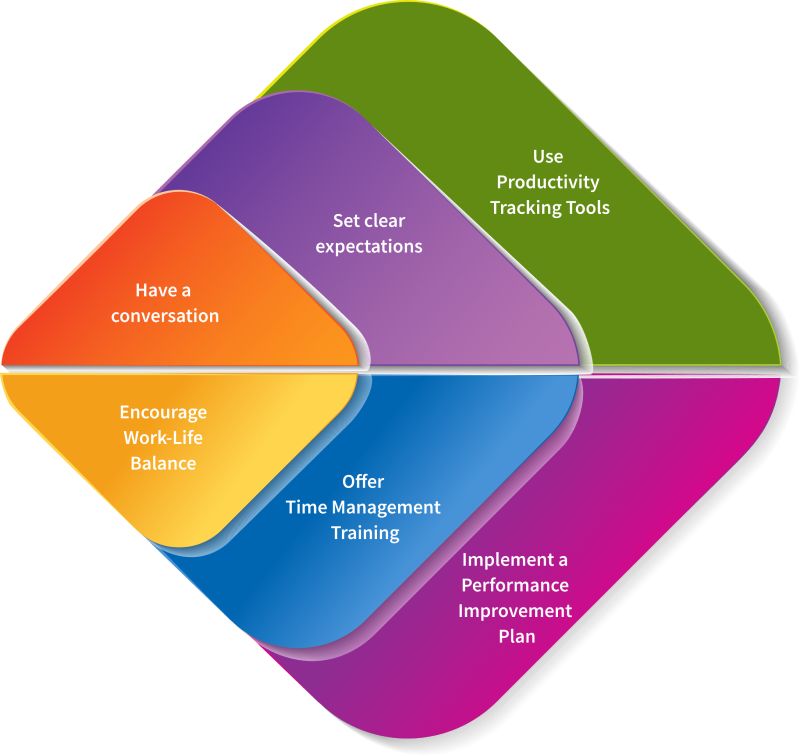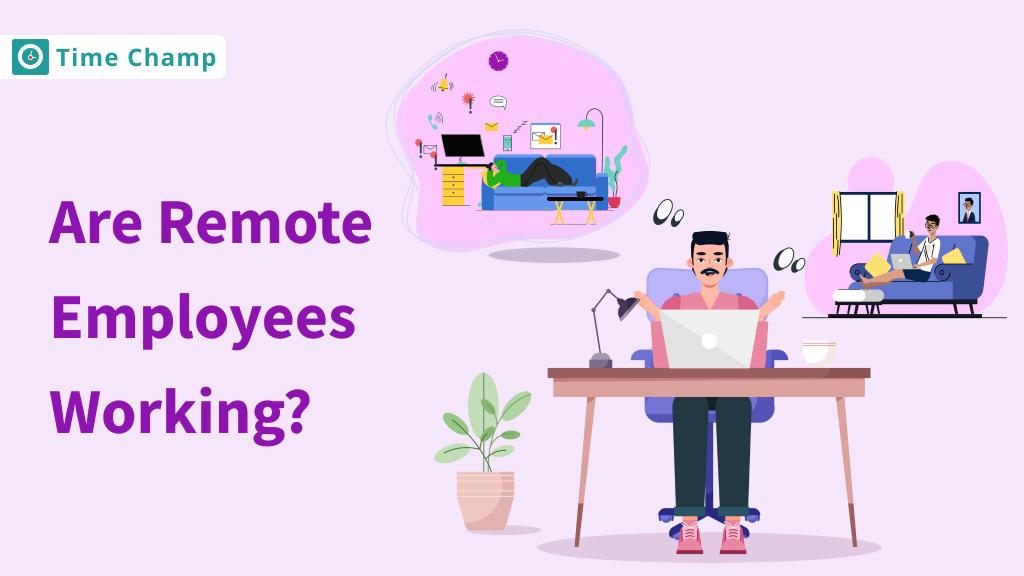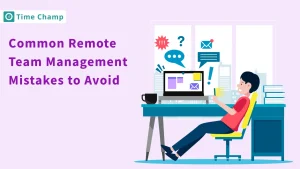In today’s world of remote work, it’s easy to wonder if your remote employees are staying productive without the traditional office setting. Are they focused, engaged, and delivering results, or are distractions taking over? While remote work offers flexibility and freedom, it also presents unique challenges in ensuring accountability and maintaining productivity. So, how can you confidently know if your remote employees are working? Don’t worry, I’ve got you covered with some practical tips to help you easily monitor your remote employees’ work status and assess their productivity levels.
7 Ways to Know If Your Employees Are Working
Knowing if your remote employees are working can be a confusing task without proper measures, your employees might face communication and collaboration issues with their teammates leading to decreased productivity.
In a recent survey, 86% of remote workers rated their productivity as good or excellent. This means only a few people slack off while working remotely.
Let’s take a look at some top ways to know if your remote employees are working or not.
1. Use Employee Monitoring Software
Employee monitoring tools offer a wide range of insights to employers about their employee’s activities and productivity levels, even if they are working from across the globe.
Here’s a small overview of what employee monitoring tools like Time Champ offers you.
Monitor Employee Real-Time Activities
You can easily view which websites and apps your remote employees use and for how long, whether are they productive or non-productive (categorized based on how you configure apps for your teams).
Track Time Spent on Tasks and Projects
Time tracking features allow you to see exactly how much time remote employees spend on each task or project, helping to evaluate workload efficiency and plan resources more effectively. This feature supports billing and productivity tracking, making it especially valuable for remote teams.
Record Audio and Location
You can locate your remote employees and field employees using these tools and if you have a call center or related to BPO then you can track your employee device audio to ensure call quality and work efficiency.
Capture Screenshots and Screen Recordings
Get real-time views of your employee’s screen using real-time screenshots and screen recordings. These captures can also act as visual activity logs and proof of work.
Set Up Real-Time Alerts
You can configure real-time alerts based on your company policies and rules. You can set up alerts for when your employee productivity drops or when any suspicious activity is detected.
Receive Comprehensive Reports
You can get reports for productivity, activity, attendance, work logs, and more with Time Champ. You can also download these reports with a single click and store them safely.
Want to know more about employee monitoring? Here’s a detailed guide: Everything You Need to Know About Employee Monitoring
2. Check Their Timesheets
You can check your remote employee timesheets, to ensure they are working and not just wasting their time by keeping their screens on.
They help monitor any employee’s clock-in and clock-out hours. Timesheets can capture essential information concerning particular hour rates, absenteeism, job roles, total hours worked, and ongoing tasks. They also help offer attendance patterns, break times, and overtime hours. They also enable the generation of productivity reports in real time while smoothing payroll and invoicing to ensure real-time payment and billing.
3. Review EOD Updates
End-of-the-day updates can be very beneficial for employers to know what their employees have done all day during work hours.
Ask your employees for end-of-the-day reports, ask them to list out briefly the activities they have done in the day, and review them regularly to ensure they are working efficiently every day without slacking off.
Additionally, regular feedback on these reports also motivates remote employees to stay on task and be more accountable for their time.
4. Set Key Performance Indicators
Are your remote employees hitting their targets? Tracking Key Performance Indicators (KPIs) can help you measure team productivity and outcomes. KPIs offer a clear, quantifiable way to assess work progress and align individual efforts with business goals. By setting specific, measurable, achievable, relevant, and timely (SMART) KPIs, you can evaluate each team member’s contribution to the company.
Here are some examples of KPI’s:
- Make 70 sales calls per day
- Achieve an average handle time on inbound calls of 2 minutes
- Decrease the coding time by 10%
- Hold 5 product demos per week to increase the conversion.
- Contact at least 20 new potential clients in a day to generate leads.
- Work on at least 5 customer support tickets per hour to reduce the response time.
After establishing those KPIs for each member of the team, clearly communicate these goals to your employees. Explain the methods and timing for measuring these metrics and motivate them to monitor their progress on a daily or weekly basis instead of relying solely on quarterly or annual reviews.
Also Read: How Remote Work Impacts Employee Productivity
5. Track Location and Use Geo-Fencing
If you have field employees, then geo-fencing and location can be your best savior. You can track where your field or remote employees are and for how long they stayed at each location. This helps you optimize field operations, reduce time theft, and enhance productivity.
Additionally, real-time location data enables you to assign tasks more efficiently based on proximity, ensuring quick response times. By gaining insights into movement patterns, you can also identify areas for improvement and allocate resources more effectively.
6. Monitor Social Media Activities
If you’ve tried contacting employees through emails, chat, or internal tools without much success, checking their social media activity might give you a clue about their productivity. Check if they are busy tweeting, liking, or sharing posts on Twitter, Facebook, or LinkedIn during work hours. Taking breaks is fine, but if they’re unresponsive and not getting work done, it could be a red flag.
It may indicate that they’re distracted or disengaged, leading to a drop in work quality and missed deadlines. If this becomes a pattern, it might be time to address the situation and find out what’s affecting their focus.
You can use tools like Time Champ to track your employees online activities and get detailed reports on what app or website your employees are using and for how long.
7. Check Employee Emails
Keeping an eye on emails can give you clues about when an employee is active. If you notice they’ve just sent or received a message, it’s a good sign they’re engaged. On the other hand, if their email activity seems to have stalled for a while, it might be a good idea to check in with them or their teammates.
They could be focused on a demanding task, feeling unwell, or simply away from their desk.
Keep in mind that employers can only monitor employees’ work email and only during work hours, monitoring employee’s personal emails is considered an invasion of privacy and most of the employees resist such monitoring.
Monitoring emails can also shed light on communication trends, such as how many emails are sent and received, response times, and even the content to identify any potential policy breaches or inappropriate conduct. This oversight helps you ensure employees are using resources wisely and following company guidelines.
Signs Your Employees Aren’t Working and Tips to Address
Here are some key signs to know if your remote employees are working and some tips to address inefficiencies.
1. Decline in Work Quality
A non-productive employee’s first symptom is a huge decrease in their work quality. Look for such cases where your remote employees submit low-quality unfinished, and OK-OK type work without putting much effort into what they are doing and show less involvement in projects and tasks.
There might be different reasons for this sudden drop in work quality. It might be because of a lack of motivation or recognition, and they might also feel their work is not being valued and not making any difference in the organization’s goals.
Pro Tip
Make your employees feel valued, recognize their work, and appreciate them whenever possible.
2. Inconsistent or Poor Communication
We all have that one team member who’s like a digital ghost—never seen, rarely heard. In remote work, communication is everything. Did you know that 78% of employees believe regular communication improves their productivity? If your employee is responding to Slack messages at odd hours or giving you one-word responses, something’s off. Inconsistent communication is a silent productivity killer.
Pro Tip
Create a quirky communication rule, like a "Two-Minute Slack Rule" where employees should respond to non-urgent messages within two minutes during work hours, or use a fun emoji system for status updates (A red apple = busy, A brain emoji = deep work, A beaming rocket = super productive).
3. Missed Deadlines or Delayed Responses
If your employees start missing deadlines as often as people miss alarm clocks on Monday mornings, it’s time to take notice. In fact, many remote managers cite missed deadlines as a key sign of decreased productivity. And if they lag in responding to urgent tasks, that’s another red flag you must notice.
Pro Tip
Add a little fun to your deadlines by having themed reminders "Mission Impossible" for those that are really urgent or "Beat the Clock" for time-sensitive projects. Allow workers to feel like they're in an action movie instead of one of those ordinary days at work!
4. Frequently Unavailable or Absent
You’re calling a team member for a meeting, but they’re always Missing. Even worse, they’re frequently offline during key work hours. Being unavailable isn’t just an inconvenience, it’s a productivity killer. Statistics show that unplanned absences cost employers 21% in productivity loss. If you find an employee frequently slipping away, it’s time for a deeper conversation.
Pro Tip
Plan a one-on-one session and ask what’s making them slip away every time and take action based on the response.
Pro Tip
Introduce a "Remote Attendance Trophy", a virtual trophy that gets passed around weekly to the most reliable team member. You can then tie it to availability, punctuality, and responsiveness to add a fun recognition layer.
5. Increased Use of Social Media or Personal Activities
It’s tempting to take a quick peek at Instagram, but when that 5-minute scroll turns into 30 minutes, productivity is officially at risk. According to studies, 89% of employees admit they waste their time on social media during work hours-that is about 40 minutes lost each day. Nobody would mind some time off, however excessive personal activities can delay progress.
Pro Tip
Launch a "No-Scroll Challenge" where employees commit to avoiding social media during work hours for a week. Create a leaderboard and offer small rewards (like a virtual coffee chat or digital gift card) for those who stay focused.
6. Dodging Responsibilities
Have you ever asked a team member to take on a project, only to hear endless excuses or notice they’re passing off tasks? The very subtle sign of burnout or disengagement is the avoidance of responsibility. Most employees point toward burnout as the top reason for avoiding responsibility, and that avoidance could grow into a much bigger problem.
Pro Tip
Implement a "Project Ownership Spotlight" where employees are encouraged to take ownership of projects. Every week, highlight one employee who showed exceptional leadership, and give them a fun award, like "Project Captain" or "Responsibility Rockstar."
7. Complaints from Colleagues or Clients
If you’re already noticing complaints from teammates or clients about failed deadlines or poor communication, then it’s time to look into the issue. Most workplace conflicts begin because of uneven workloads and lack of accountability. Don’t wait for complaining to build, nip it in the bud and take action on the root cause immediately.
Pro Tip
Start a "Feedback Friday" where team members can share anonymous feedback about workflow issues. Make it fun by allowing employees to share what went right and what could be improved, but end on a positive note with a “Team MVP” shout-out each week.
What to do if Your Remote Employees Aren’t Working

If you notice your remote employees are not giving their best effort, do not worry, here are six powerful steps to get your team back on track and firing on all cylinders.
Have a conversation
Start with the basics: Have an honest and open conversation with your employee. More often than not, a simple check-in will reveal some challenges that are distracting – burnout or unclear expectations.
Address the conversation with empathy but stay firm. Try asking questions like, “Is there anything impacting your focus? How can we support you in being more productive?” This might open the door to finding solutions together.
Tip for You: Right after the conversation Develop a small action plan with the employee where they outline what they need to improve. This shows accountability without micromanaging.
Set clear expectations
Vagueness is the enemy of productivity. Make sure your remote employees know exactly what’s expected of them. Be clear about deadlines, the quality of work you expect, and how you will measure success. Setting specific goals like “Complete X by this date” or “Respond within 24 hours” can prevent misunderstandings.
Tip for You: Time Champ’s Project Management feature helps you assign tasks to every team member, track their performance, and see if they are meeting deadlines. You can also monitor project progress and costs in real time. This visual aid helps clarify expectations and promotes accountability.
Use Productivity Tracking Tools
You don’t need to become a helicopter manager but using productivity software like Time Champ can give you a clear picture of how your remote employees are spending their work hours. These tools help track task completion, and time spent on various activities, and can even offer insights into their productivity levels.
Tip for You: Share this tracked data with your employees in a positive way. Try asking, ‘Are you aware that your most productive hours are between 10 a.m. and 12 p.m.?’ How can we optimize this time?” This shifts the conversation from surveillance to optimization, turning the conversation into a more collaborative effort.
Also Read: Top 11 Software to See If Your Remote Employees Are Working
Encourage Work-Life Balance
Remote workers have a tough time disconnecting which causes them to burnout and become less productive. Ensure that your team gets the opportunity to maintain a healthy work-life balance, ensure they take regular breaks, and log off at an appropriate hour. Remote work cannot be a 24/7 mode of working.
Tip for You: Run a “Wellness Challenge” where employees log their self-care activities, like taking a walk or having a proper lunch break. Celebrate small wins, like “The most relaxed employee of the week”-it is a great way of encouraging balance while being fun for the team.
Offer Time Management Training
If your employees are struggling with productivity, they might just need help with better time management. Consider offering a workshop or some one-on-one coaching. There are countless techniques in time management, the Pomodoro technique or time-blocking, to ensure your remote employees stay on schedule.
Tip for You: Introduce a “Time Mastery Challenge.” Brief staff on several time management techniques. Have them try them out for one week, and then host a team discussion with everyone on how things are working out best for each individual. This keeps things light and interactive while helping improve productivity.
Implement a Performance Improvement Plan
If you’ve tried the above steps and things still aren’t improving, it may be time to implement a Performance Improvement Plan (PIP). This formal plan outlines specific areas that need improvement, provides resources for support, and sets clear deadlines for progress. A PIP isn’t just a punishment, it’s a structured way to help employees succeed.
Tip for You: Introduce the PIP with a positive note. Instead of focusing on failure, describe it as an organized growth plan. Express yourself something like this: “This is a road map to get back on track but with assistance at each step along the way.”
Conclusion
In conclusion, knowing if your remote employees are truly engaged and productive can be tricky. By applying the tips discussed, you can effectively monitor their performance and foster a supportive environment that promotes success.
Start by having open conversations, setting clear expectations, and utilizing productivity tools like Time Champ to unlock your team’s full potential. Don’t forget to add some fun to your approach with quirky communication rules and themed deadlines to boost morale.
If challenges persist, consider implementing a Performance Improvement Plan as a collaborative roadmap to guide your employees toward success.
Take action today by picking one or two tips to implement this week and watch your team’s performance improve. With the right strategies, you can ensure your remote employees are not just working but thriving!
Curious if your remote employees are truly productive?
Try Time Champ today and gain real-time insights into their performance and efficiency!
Signup for FreeBook DemoFrequently Asked Questions
Signs may include missed deadlines, low-quality work submissions, lack of communication, and disengagement in team discussions. Besides, if team members avoid contributing to discussions or will not attend meetings but occasionally attend to participate, it is almost a reflection of a lack of interest in their responsibilities.
You can measure productivity through tracking tools like Time Champ that monitor task completion, time spent on activities, and overall project progress. Reporting mechanisms set up and in place will enable you to monitor performance over any given period and trends in productivity.
Regular check-ins, such as weekly or bi-weekly meetings, are effective for maintaining communication and understanding employee challenges. These check-ins can also become a meeting ground for giving and receiving feedback from colleagues, discussing problems and sharing success.
The discussion should be open about workload, encourage the practice of self-care, and give remote employees full access to mental health resources for burnout. Providing access to regular vacations or personal days through facilitating employees is also good for the mental health of employees.
Define clear measurable goals and timelines, then use project management tools to keep everyone on track. At regular team meetings, make sure you remember to revisit these expectations for everyone.





